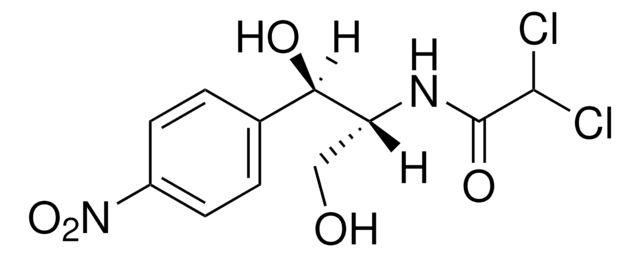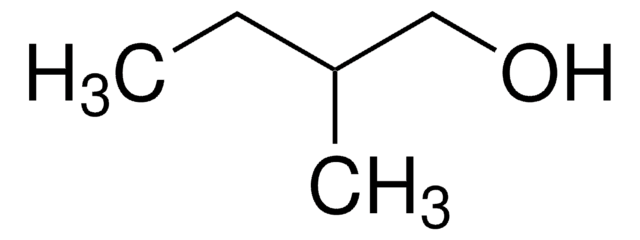320021
3-Methyl-1-butanol
ACS reagent, ≥98.5%
동의어(들):
Isoamyl alcohol, Isopentyl alcohol
로그인조직 및 계약 가격 보기
모든 사진(3)
About This Item
Linear Formula:
(CH3)2CHCH2CH2OH
CAS Number:
Molecular Weight:
88.15
Beilstein:
1718835
EC Number:
MDL number:
UNSPSC 코드:
12352001
PubChem Substance ID:
NACRES:
NA.21
bp:
130 °C (lit.)
vapor pressure:
2 mmHg ( 20 °C)
추천 제품
Grade
ACS reagent
Quality Level
vapor density
3 (vs air)
vapor pressure
2 mmHg ( 20 °C)
분석
≥98.5%
양식
liquid
autoignition temp.
644 °F
expl. lim.
1.2-9 %, 100 °F
dilution
(for analytical testing)
불순물
≤0.002 meq/g Titr. acid
≤0.1% carbonyl (as HCHO)
≤0.2% acids and esters (as amyl acetate)
≤0.5% water
증발 잔류물
≤0.003%
refractive index
n20/D 1.406 (lit.)
pH
5.6 (20 °C, 25 g/L)
bp
130 °C (lit.)
mp
−117 °C (lit.)
density
0.809 g/mL at 25 °C (lit.)
SMILES string
CC(C)CCO
InChI
1S/C5H12O/c1-5(2)3-4-6/h5-6H,3-4H2,1-2H3
InChI key
PHTQWCKDNZKARW-UHFFFAOYSA-N
유사한 제품을 찾으십니까? 방문 제품 비교 안내
일반 설명
3-methyl-1-butanol is a clear, colorless alcohol. It is one of several isomers of amyl alcohol. It is commonly used as a solvent in various applications, such as inks, coatings, and pharmaceutical preparations.
애플리케이션
3-Methyl-1-butanol is used as a:
- Dissolution of a wide range of organic compounds and is often employed for extraction, dilution, and preparation of samples for analysis.
- Starting material or reagent in organic synthesis. It can be incorporated into various reactions to introduce the isoamyl group or alcohol functionality into target molecules.
신호어
Danger
유해 및 위험 성명서
Hazard Classifications
Acute Tox. 4 Inhalation - Eye Dam. 1 - Flam. Liq. 3 - Skin Irrit. 2 - STOT SE 3
표적 기관
Respiratory system
Storage Class Code
3 - Flammable liquids
WGK
WGK 1
Flash Point (°F)
110.3 °F - closed cup
Flash Point (°C)
43.5 °C - closed cup
이미 열람한 고객
Mary J Dunlop et al.
Molecular systems biology, 7, 487-487 (2011-05-11)
Many compounds being considered as candidates for advanced biofuels are toxic to microorganisms. This introduces an undesirable trade-off when engineering metabolic pathways for biofuel production because the engineered microbes must balance production against survival. Cellular export systems, such as efflux
Kazushi Yoshida et al.
Nature communications, 3, 739-739 (2012-03-15)
The same odorant can induce attractive or repulsive responses depending on its concentration in various animals including humans. However, little is understood about the neuronal basis of this behavioural phenomenon. Here we show that Caenorhabditis elegans avoids high concentrations of
Frédéric Ravyts et al.
Food microbiology, 27(7), 945-954 (2010-08-07)
Differences in the production of bacterial metabolites with potential impact on fermented sausage flavour were found in meat simulation medium when comparing different strains of Staphylococcus xylosus and Staphylococcus carnosus as starter cultures. Overall, higher levels of 3-methyl-1-butanol and acetoin
Niels O Verhulst et al.
Malaria journal, 10, 28-28 (2011-02-10)
Anopheles gambiae sensu stricto is considered to be highly anthropophilic and volatiles of human origin provide essential cues during its host-seeking behaviour. A synthetic blend of three human-derived volatiles, ammonia, lactic acid and tetradecanoic acid, attracts A. gambiae. In addition
Silvio Zaina et al.
Circulation. Cardiovascular genetics, 7(5), 692-700 (2014-08-06)
Epigenetic alterations may contribute to the development of atherosclerosis. In particular, DNA methylation, a reversible and highly regulated DNA modification, could influence disease onset and progression because it functions as an effector for environmental influences, including diet and lifestyle, both
자사의 과학자팀은 생명 과학, 재료 과학, 화학 합성, 크로마토그래피, 분석 및 기타 많은 영역을 포함한 모든 과학 분야에 경험이 있습니다..
고객지원팀으로 연락바랍니다.






